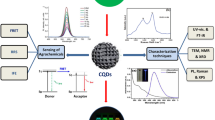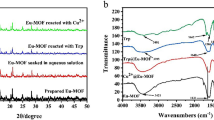Abstract
In the present study, spectroscopic determinations of copper ions using chimeric metal-binding green fluorescent protein (His6GFP) as an active indicator have been explored. Supplementation of copper ions to the GFP solution led to a remarkable decrease of fluorescent intensity corresponding to metal concentrations. For circumstances, rapid declining of fluorescence up to 60% was detected in the presence of 500 μM copper. This is in contrast to those observed in the case of zinc and calcium ions, in which approximately 10–20% of fluorescence was affected. Recovery of its original fluorescence up to 80% was mediated by the addition of ethylenediamine tetraacetic acid. More importantly, in the presence of metal ions, the emission wavelength maximum remains unchanged while reduction of the optical density of the absorption spectrum has been observed. This indicates that the chromophore’s ground state was possibly affected by the static quenching process. Results from circular dichroism measurements revealed that the overall patterns of circular dichroism spectra after exposure to copper ions were not significantly different from that of the control, where the majority of sharp positive band around 195–196 nm in combination with a broad negative deflection around 215–216 nm was obtained. Taken together, it can be presumed that copper ions exerted their static quenching on the fluorescence rather than structural or conformational alteration. However, notification has to be made that some peptide rearrangements may also occur in the presence of metal ions. Further studies were conducted to investigate the feasibility of using the His6GFP as a sensing unit for copper ions. The His6GFP was encapsulated in Sol-gel and immobilized onto the optical fiber connected with a fluorescence detecting device. The Sol-gel was doped into the metal solution where the quenching of fluorescence could be monitored in real time. The sensing unit provided a high sensitivity of detection in the range of 0.5 μM to 50 mM with high selectivity for copper ions. All these findings open up a high potential to apply the fluorescent protein-based bioanalytical tool for copper determination in the future.










Similar content being viewed by others
References
Kim BE, Nevitt T, Thiele DJ (2008) Mechanisms for copper acquisition, distribution and regulation. Nat Chem Biol 4:176–185
Fitzgerald DJ (1998) Safety guidelines for copper in water. Am J Clin Nutr 67:1098S–1102S
Krupanidhi S, Sreekumar A, Sanjeevi CB (2008) Copper & biological health. Indian J Med Res 128:448–461
Abu-Shawish HM, Saadeh SM, Hussien AR (2008) Enhanced sensitivity for Cu(II) by a salicylidine-functionalized polysiloxane carbon paste electrode. Talanta 76:941–948
Singh LP, Bhatnagar JM (2004) Copper(II) selective electrochemical sensor based on Schiff Base complexes. Talanta 64:313–319
Khatua S, Choi SH, Lee J et al (2009) Highly selective fluorescence detection of Cu2+ in water by chiral dimeric Zn2+ complexes through direct displacement. Inorg Chem 48:1799–1801
Prachayasittikul V, Isarankura-Na-Ayudhya C, Mejare M et al (2000) Construction of chimeric histidine-6-green fluorescent protein: role of metal on fluorescent characteristic. Thammasat Int J Sci Tech 5:61–68
Richmond TA, Takahashi TT, Shimkhada R et al (2000) Engineered metal binding sites on green fluorescence protein. Biochem Biophys Res Commun 268:462–465
Prachayasittikul V, Isarankura-Na-Ayudhya C, Bulow L (2001) Lighting E. coli cells as biological sensors for Cd2+. Biotechnol Lett 23:1285–1291
Barondeau DP, Kassmann CJ, Tainer JA et al (2002) Structural chemistry of a green fluorescent protein Zn biosensor. J Am Chem Soc 124:3522–3524
Tansila N, Tantimongcolwat T, Isarankura-Na-Ayudhya C et al (2007) Rational design of analyte channels of the green fluorescent protein for biosensor applications. Int J Biol Sci 3:463–470
Eli P, Chakrabartty A (2006) Variants of DsRed fluorescent protein: development of a copper sensor. Protein Sci 15:2442–2447
Sumner JP, Westerberg NM, Stoddard AK et al (2006) DsRed as a highly sensitive, selective, and reversible fluorescence-based biosensor for both Cu+ and Cu2+ ions. Biosens Bioelectron 21:1302–1308
Sumner JP, Westerberg NM, Stoddard AK et al (2006) Cu+- and Cu2+-sensitive PEBBLE fluorescent nanosensors using DsRed as the recognition element. Sens Actuators B Chem 113:760–767
Rahimi Y, Shrestha S, Banerjee T et al (2007) Copper sensing based on the far-red fluorescent protein, HcRed, from Heteractis crispa. Anal Biochem 370:60–67
Rahimi Y, Goulding A, Shrestha S et al (2008) Mechanism of copper induced fluorescence quenching of red fluorescent protein, DsRed. Biochem Biophys Res Comm 370:57–61
Pakhomov AA, Martynov VI (2008) GFP family: structural insights into spectral tuning. Chem Biol 15:755–764
Tsien RY (1998) The green fluorescent protein. Annu Rev Biochem 67:509–544
Stepanenko OV, Verkhusha VV, Kuznetsova IM et al (2008) Fluorescent proteins as biomarkers and biosensors: throwing color lights on molecular and cellular processes. Curr Protein Pept Sci 9:338–369
Bizzarri R, Serresi M, Luin S et al (2009) Green fluorescent protein based pH indicators for in vivo use: a review. Anal Bioanal Chem 393:1107–1122
Suwanwong Y, Isarankura-Na-Ayudhya C, Bulow L et al (2006) Insights into the genetic re-engineering of chimeric antibody-binding green fluorescent proteins for immunological taggers. EXCLI J 5:164–178
VanEngelenburg SB, Palmer AE (2008) Fluorescent biosensors of protein function. Curr Opin Chem Biol 12:60–65
Prachayasittikul V, Isarankura-Na-Ayudhya C, Boonpangrak S et al (2004) Lipid-membrane affinity of chimeric metal-binding green fluorescent protein. J Membr Biol 200:47–56
Isarankura-Na-Ayudhya C, Prachayasittikul V, Galla HJ (2004) Binding of chimeric metal-binding green fluorescent protein to lipid monolayer. Eur Biophys J 33:522–534
Prachayasittikul V, Isarankura-Na-Ayudhya C, Tantimongcolwat T et al (2005) Nanoscale orientation and lateral organization of chimeric metal-binding green fluorescent protein on lipid membrane determined by epifluorescence and atomic force microscopy. Biochem Biophys Res Comm 326:298–306
Prachayasittikul V, Isarankura-Na-Ayudhya C, Hilterhaus L et al (2005) Interaction analysis of chimeric metal-binding green fluorescent protein and artificial solid-supported lipid membrane by quartz crystal microbalance and atomic force microscopy. Biochem Biophys Res Comm 327:174–182
Isarankura-Na-Ayudhya C, Suwanwong Y, Boonpangrak S et al (2005) Co-expression of zinc binding motif and GFP as a cellular indicator of metal ions mobility. Int J Biol Sci 1:146–151
Tansila N, Becker K, Isarankura-Na-Ayudhya C et al (2008) Metal ion accessibility of histidine-modified superfolder green fluorescent protein expressed in Escherichia coli. Biotechnol Lett 30:1391–1396
Jung K, Park J, Maeng P-J et al (2005) Fluorescence quenching of green fluorescent protein during denaturation by guanidine. Bull Korean Chem Soc 26:413–417
Visser NV, Hink MA, Borst JW et al (2002) Circular dichroism spectroscopy of fluorescent proteins. FEBS Lett 521:31–35
Kneen M, Farinas J, Li Y et al (1998) Green fluorescent protein as a noninvasive intracellular pH indicator. Biophys J 74:1591–1599
Mayr T, Werner T (2002) Highly selective optical sensing of copper(II) ions based on fluorescence quenching of immobilised Lucifer Yellow. Analyst 127:248–252
Chavez-Crooker P, Garrido N, Ahearn GA (2001) Copper transport by lobster hepatopancreatic epithelial cells separated by centrifugal elutriation: measurements with the fluorescent dye Phen Green. J Exp Biol 204:1433–1444
Breuer W, Epsztejn S, Millgram P et al (1995) Transport of iron and other transition metals into cells as revealed by a fluorescent probe. Am J Physiol 268:C1354–C1361
McCall KA, Fierke CA, Mulnard RA et al (2000) Colorimetric and fluorimetric assays to quantitate micromolar concentrations of transition metals. Anal Biochem 284:307–315
Baird GS, Zacharias DA, Tsien RY (2000) Biochemistry, mutagenesis, and oligomerization of DsRed, a red fluorescent protein from coral. Proc Natl Acad Sci U S A 97:11984–11989
Lauf U, Lopez P, Falk MM (2001) Expression of fluorescently tagged connexins: a novel approach to rescue function of oligomeric DsRed-tagged proteins. FEBS Lett 498:11–15
Acknowledgments
This project was supported in part by the Young Scholars Research Fellowship from The Thailand Research Fund to T.T. (grant no. MRG5080158), the Deutsche Forschungsgemeinschaft (DFG) and the Bundesministerium fur wirtschaftliche Zusammenarbeit und Entwicklung (Federal Ministry for Economic Cooperation and Development; BMZ; grant no.GA233/19–1,2) and the annual budget grant of Mahidol University (B.E. 2551-2555). The authors would like to thank Prof. Dr. Hans-Ulrich Humpf (Institut für Lebensmittelchemie, Westfälische Wilhelms Universität) for his assistance on the operation of CD measurements.
Author information
Authors and Affiliations
Corresponding author
Rights and permissions
About this article
Cite this article
Isarankura-Na-Ayudhya, C., Tantimongcolwat, T., Galla, HJ. et al. Fluorescent Protein-Based Optical Biosensor for Copper Ion Quantitation. Biol Trace Elem Res 134, 352–363 (2010). https://doi.org/10.1007/s12011-009-8476-9
Received:
Accepted:
Published:
Issue Date:
DOI: https://doi.org/10.1007/s12011-009-8476-9




